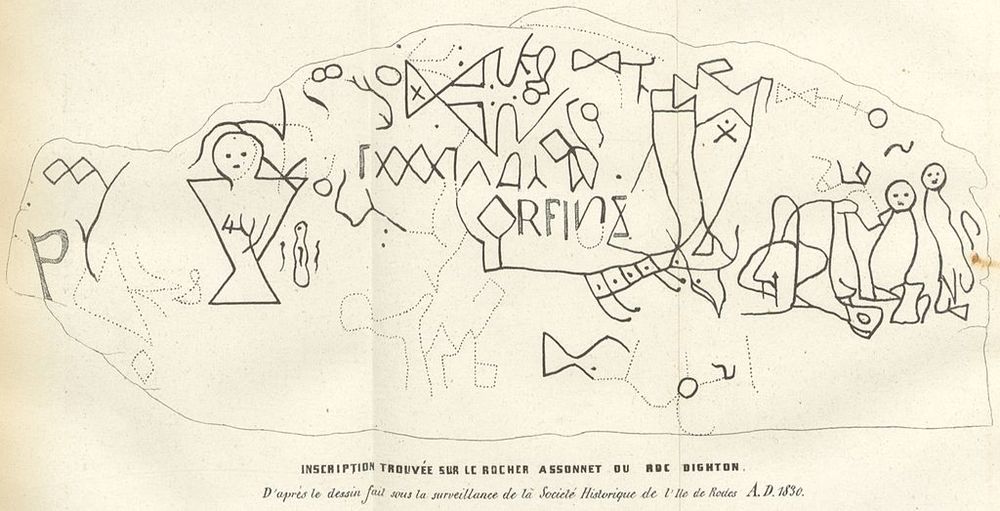On the shores of Taunton River at Berkley, Massachusetts, stands a small museum with a single but massive exhibit—a 40-ton rock that was fished out of the riverbed and installed here in 1963—the famous Dighton Rock named after the former town of Dighton where it was found. The rock’s fame lies in the indecipherable inscriptions carved on its face that has puzzled scholars since the 17th century.
The petroglyphs, primarily made up of straight lines and geometric shapes, are accompanied by very basic drawings of people along with writing that are known. It almost looks like random doodles made by people who had nothing better to do, but people are convinced they hide a secret message.

The Dighton Rock in 1893.
The Dighton Rock is approximately 5 feet high, 9.5 feet wide, and 11 feet long. The surface with the inscriptions is inclined and once faced the sea where it could have been seen by any approaching boat or ship. Through the centuries, therefore, it was speculated that the carvings was a message left by visitors to the coast, intended to catch the eye of subsequent maritime explorers passing that way.
One of the first mentions of the Dighton Rock can be found in 1680 when the English colonist Rev. John Danforth made a drawing of the petroglyphs, which has been preserved in the British Museum. However, Danforth’s drawing conflicts with other reports on the rock at a similar time. In 1690 Rev. Cotton Mather described the rock in his book The Wonderful Works of God Commemorated:
Among the other Curiosities of New-England, one is that of a mighty Rock, on a perpendicular side whereof by a River, which at High Tide covers part of it, there are very deeply Engraved, no man alive knows How or When about half a score Lines, near Ten Foot Long, and a foot and half broad, filled with strange Characters: which would suggest as odd Thoughts about them that were here before us, as there are odd Shapes in that Elaborate Monument.
During the 19th century, many popular publications and public figures mentioned the rock. The poet and critic James Russell Lowell suggested that it should be mentioned by presidential candidates in letters to newspapers: "If letters must be written, profitable use might be made of the Dighton rock hieroglyphic or the cuneiform script, every fresh decipherer of which is enabled to educe a different meaning.” Lowell made other references to the rock in his widely circulated satirical writing, and may thus have helped to popularize it.

A copy of the inscription on Dighton Rock.
Different Theories
One of the most influential theories was put forward in 1837 by a Danish scholar, Carl Christian RaIn, who suggested that the carvings were made by Vikings and represented the Norse saga of Thorfinn Karlselne and his voyage to the North American coast to a place called Hop, where his wife Gudrida gave birth to his son Snorro. Raln’s theory piqued the interest of the Rhode Island Historical Society, who contacted their friends in Denmark, and together they found ample proof to declare that Hop lay on the Taunton River.
Rafn’s researches excited international enthusiasm, and from 1837 onwards, the theory of pre-Columbian explorations of North America by the Vikings was almost universally accepted. Dighton Rock formed the last link in a long chain of evidence. Alas, the Viking theory of the rock was shredded to pieces in 1916 by the late Professor Edmund B. Delabarre of Brown University. Delabarre found gross discrepancies between the society’s actual drawings and the doctored-up copies reproduced in Rafn’s book. Apparently, Rafn had added many lines to the drawings to support his theory.

While studying the inscription, Delabarre found what appeared to be the name “Miguel Cortereal” and the date 1511 scribbled across among the lines and markings. Delebarre claimed that the message is an abbreviated Portuguese-style Latin, which can be translated to say “I, Miguel Cortereal, 1511. In this place, by the will of God, I became a chief of the Indians”.
But who was Miguel Cortereal?
Miguel Cortereal was a Portuguese explorer who had set out from Lisbon in 1502 in search of his brother Gaspar who had got lost two years previously near Newfoundland. The expedition apparently reached the location where Gaspar's party had landed, at which point the three ships broke off in different directions to search. Later, the ship carrying Miguel failed to appear at a designated rendezvous. The other two ships made the return voyage to Portugal, while Miguel and his ship were never seen again.
Delabarre speculated that Miguel Cortereal reached Mount Hope Bay in 1502 and sent men ashore near the site of Dighton Rock. Perhaps there was a battle with the Wampanoag Indians, perhaps a shipwreck, or perhaps for other reasons Miguel joined the Wampanoags. Cortereal lived with the Wampanoags for several years keeping close watch for vessels along the coast. But by 1511, his hopes of rescue having dimmed, he carved the message on the rock where it would stand for future generations.
Delabarre’s theory is widely accepted in Portugal, but not much elsewhere. It was severely criticized by American historian Samuel Eliot Morison in his 1971 book The European Discovery of America: The Northern Voyages.
Other theories have attributed these carvings to Phoenicians and even to the Chinese, who according to author Gavin Menzies sailed to America before Columbus.
The Dighton Rock continue to be debated endlessly among scholars, but it does not drive much tourists to the Dighton Rock State Park that was established in 1955. When Roadside America visited the museum, they found that they were the only tourists. Park Service employee Milt told them, “It's not visited all that often," to which his colleague Bob added "You don't see too many people."
References:
# Edward Brecher, The Enigma Of Dighton Rock, American Heritage
# Roadside America












Comments
Post a Comment